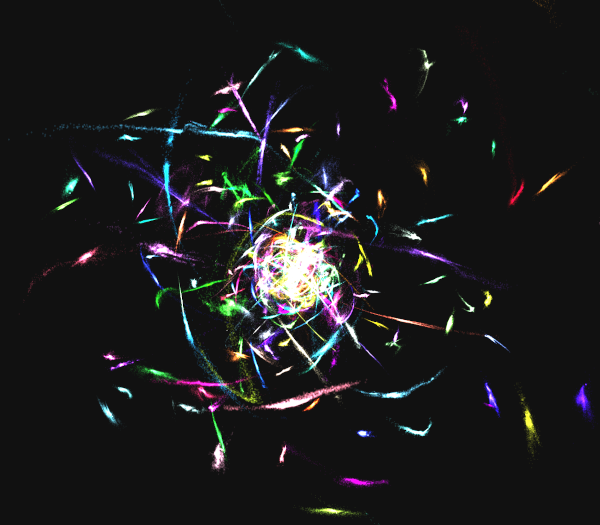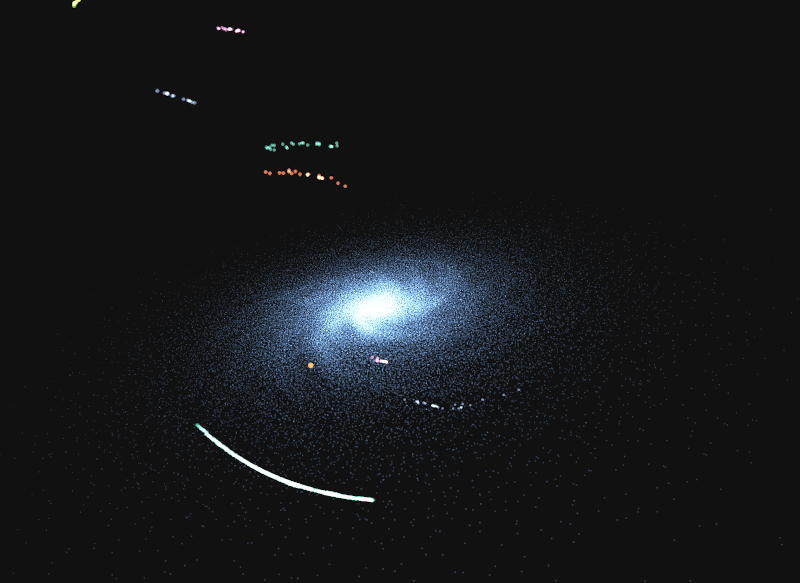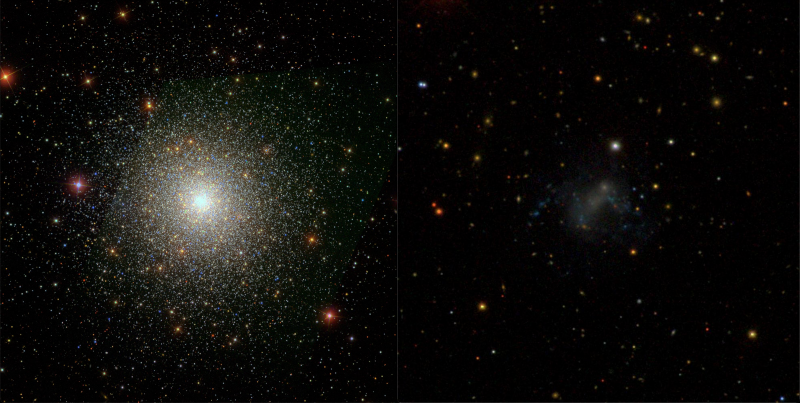An interactive version of this figure is available on Adrian Price-Whelan’s website.
Image credit: A. Price-Whelan / A. Küpper / J. Diemand
In results presented this week at the 237th meeting of the American Astronomical Society, scientists from the Apache Point Observatory Galactic Evolution Explorer (APOGEE) survey, part of the Sloan Digital Sky Survey (SDSS), have presented results that help pinpoint the origin of one of the most recently discovered stellar streams in the Milky Way.
Throughout its history, the Milky Way has undergone collisions with dozens of smaller galaxies. As these galaxies are pulled into the Milky Way, tidal forces rip them apart, a process that forms a network of streams of stars arcing through the halo of our Galaxy like confetti streamers.
Within this network, some of the streams may be connected to each other, and may have originated from the same infalling galaxy. Disentangling this complicated web can reveal important clues into the formation processes of our Milky Way.
The Jhelum Stellar stream is one of the most recently discovered streams in the Milky Way’s inner halo. Previously, its origin was not agreed on. The team was interested to see if it might be associated with a significant major merger that the Milky Way experienced early in its history, an event known as the Gaia-Enceladus-Sausage merger. Debris from this merger is found all over our Galaxy, including the part of the sky where the Jhelum stream is found, making the possibility of a connection tantalizing.
Image credit: A. Price-Whelan
Data from the APOGEE survey are stellar spectra, a scientific technique which splits light from stars into detailed rainbows, which like barcodes can be used to reveal both stars’ chemical makeup and motions. APOGEE has made these spectral measurements for hundreds of thousands of stars across the sky.
The team made use of these spectra, or stellar rainbows, from the APOGEE survey, along with precise stellar positions from the European Space Agency’s Gaia mission. This allowed them to identify the brightest known red giant star in the Jhelum stream, which was on a very different track (or orbit) to what would have been expected from a remnant of the Gaia-Enceladus-Sausage merger.
Senior author Allyson Sheffield, an associate professor of physics at LaGuardia Community College, part of the City University of New York, has early access to APOGEE data through the SDSS’s “FAST” program, which provides data access and mentoring to faculty working on research with students at historically minority serving institutions.
Allyson Sheffield
“The chemical properties of stars in a stream can be used to tell them apart from other streams.”
Prof. Sheffield explains how the APOGEE data was used to untangle the Jhelum stream, “Like fingerprints or tags, the chemical properties of stars in a stream can be used to tell them apart from other streams — but more than that, having the chemical makeup, positions and motions together is incredibly valuable, and just goes to show the benefit of combining APOGEE and Gaia.”
The Jhelum stream stretches right across the southern skies, and was inaccessible to APOGEE when i used only the 2.5m Sloan Foundation Telescope at Apache Point Observatory in New Mexico. This study has been made possible by data acquired through the use of the SDSS-IV APOGEE instrument on the Irenee du Pont Telescope at the Las Campanas Observatory in Chile. Jen Sobeck from the University of Washington, Project Manager for APOGEE-2 and Las Campanas APOGEE Operations, explains, “With nearly identical APOGEE instruments installed at telescopes in both the Northern and Southern Hemispheres, we are able to have an all-sky view of the Milky Way Galaxy, which has enabled studies like the one presented here.”
The team were able to trace the possible orbit of stars in Jhelum, and their results suggest that this stellar stream might instead be the remnant of some object other than the Gaia-Enceladus-Sausage — a different small galaxy, or perhaps even a globular cluster that was accreted by the Milky Way. Aidan Subrahimovic, an astrophysics student at CUNY who was involved with the study, explains, “Measuring the tracks, or orbits of stars in the stream allows us to almost turn back the cosmic clock, and reveal where the stream itself may have come from.”
While this result still does not conclusively link the Jhelum stream to a specific merger, it does clearly demonstrate the importance of being able to trace both the chemical make-up and motions of stars in these streams to be able to properly disentangle them. Upcoming surveys like SDSS-V’s Milky Way Mapper will continue to explore stars in the Milky Way, and may help to significantly clear up this puzzle to fully exploit the potential of these streams to reveal the history of mergers with our Galaxy.
Images (click for full-resolution versions)
Image #1
A colorful visualization of stars in a population of stellar streams that were simulated in an environment design to mimic the halo of the Milky Way. Each color is a different stream, and the markers represent star particles in the simulation.
An interactive version of this figure is available at Adrian Price-Whelan’s website
Image credit: A. Price-Whelan / A. Küpper / J. Diemand
Image #2
A visualization, which shows the Jhelum stream (in orange), and some other streams around the Milky Way. An interactive version of this figure is available online at Adrian Price-Whelan’s website.
Image credit: A. Price-Whelan
Image #3
Contacts
- Allyson Sheffield, LaGuardia Community College, City University of New York
asheffield@lagcc.cuny.edu - Aidan Subrahimovic, Macaulay Honors College, City University of New York
aidansub@gmail.com - Jennifer Sobeck, SDSS-IV Project Manager for APOGEE-2 and LCO Operations,
University of Washington, jsobeck@uw.edu - Karen Masters, SDSS Scientific Spokesperson, Haverford College
klmasters@haverford.edu, +1-610-795-6066
Twitter: @KarenLMasters / @SDSSurveys - Jordan Raddick, SDSS Public Information Officer, Johns Hopkins University, raddick@jhu.edu, +1-443-570-7105
Twitter: @raddick
About the Sloan Digital Sky Survey
Funding for the Sloan Digital Sky Survey IV has been provided by the Alfred P. Sloan Foundation, the U.S. Department of Energy Office of Science, and the Participating Institutions. SDSS acknowledges support and resources from the Center for High-Performance Computing at the University of Utah. The SDSS web site is www.sdss.org.
SDSS is managed by the Astrophysical Research Consortium for the Participating Institutions of the SDSS Collaboration including the Brazilian Participation Group, the Carnegie Institution for Science, Carnegie Mellon University, Center for Astrophysics | Harvard & Smithsonian, the Chilean Participation Group, the French Participation Group, Instituto de Astrofísica de Canarias, The Johns Hopkins University, Kavli Institute for the Physics and Mathematics of the Universe (IPMU) / University of Tokyo, the Korean Participation Group, Lawrence Berkeley National Laboratory, Leibniz Institut für Astrophysik Potsdam (AIP), Max-Planck-Institut für Astronomie (MPIA Heidelberg), Max-Planck-Institut für Astrophysik (MPA Garching), Max-Planck-Institut für Extraterrestrische Physik (MPE), National Astronomical Observatories of China, New Mexico State University, New York University, University of Notre Dame, Observatório Nacional / MCTI, The Ohio State University, Pennsylvania State University, Shanghai Astronomical Observatory, United Kingdom Participation Group, Universidad Nacional Autónoma de México, University of Arizona, University of Colorado Boulder, University of Oxford, University of Portsmouth, University of Utah, University of Virginia, University of Washington, University of Wisconsin, Vanderbilt University, and Yale University.






